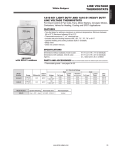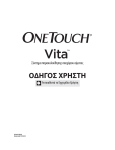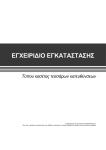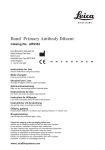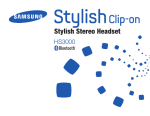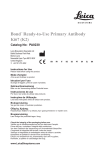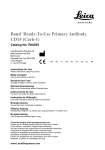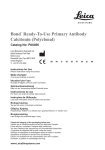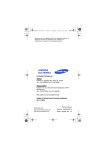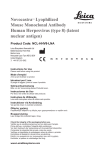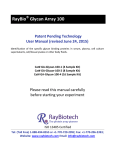Download Info - Leica Biosystems
Transcript
Bond Ready-to-Use Primary Antibody CD31 (1A10) ™ Catalog No: PA0250 Leica Biosystems Newcastle Ltd Balliol Business Park West Benton Lane Newcastle Upon Tyne NE12 8EW United Kingdom ( +44 191 215 4242 EN FR IT DE Instructions for Use Please read before using this product. Mode d’emploi Á lire avant d’utiliser ce produit. Istruzioni per L’uso Si prega di leggere, prima di usare il prodotto. Gebrauchsanweisung Bitte vor der Verwendung dieses Produkts lesen. Instrucciones de Uso Por favor, leer antes de utilizar este producto. Instruções de Utilização Leia estas instruções antes de utilizar este produto. Instruktioner vid Användning Var god läs innan ni använder produkten. Οδηγίες χρήσης Παρακαλούμε διαβάστε τις οδηγίες πριν χρησιμοποιήσετε το προϊόν αυτό. Brugsanvisning Læs venligst før produktet tages i brug. Check the integrity of the packaging before use. Vérifier que le conditionnement est en bon état avant l’emploi. Prima dell’uso, controllare l’integrità della confezione. Vor dem Gebrauch die Verpackung auf Unversehrtheit überprüfen. Comprobar la integridad del envase, antes de usarlo. Verifique a integridade da embalagem antes de utilizar o produto. Kontrollera att paketet är obrutet innan användning. Ελέγξτε την ακεραιότητα της συσκευασίας πριν από τη χρήση. Kontroller, at pakken er ubeskadiget før brug. www.LeicaBiosystems.com ES PT SV EL DA PA0250 Rev B Page 1 Bond Ready-To-Use Primary Antibody CD31 (1A10) ™ Catalog No: PA0250 Intended Use This reagent is for in vitro diagnostic use. CD31 (1A10) monoclonal antibody is intended to be used for the qualitative identification by light microscopy of human CD31 (PECAM-1) molecule in formalin-fixed, paraffin-embedded tissue by immunohistochemical staining using the automated Bond system. TM The clinical interpretation of any staining or its absence should be complemented by morphological studies and proper controls and should be evaluated within the context of the patient’s clinical history and other diagnostic tests by a qualified pathologist. Summary and Explanation Immunohistochemical techniques can be used to demonstrate the presence of antigens in tissue and cells (see “Using Bond Reagents” in your Bond user documentation). CD31 (1A10) primary antibody is a ready to use product that has been specifically optimized for use with Bond Polymer Refine Detection. The demonstration of human CD31 (PECAM-1) molecule is achieved by first, allowing the binding of CD31 (1A10) to the section, and then visualizing this binding using the reagents provided in the detection system. The use of these products, in combination with the automated Bond system, reduces the possibility of human error and inherent variability resulting from individual reagent dilution, manual pipetting and reagent application. Reagents Provided CD31 (1A10) is a mouse anti-human monoclonal antibody produced as a tissue culture supernatant, and supplied in Tris buffered saline with carrier protein, containing 0.35% ProClin 950 as a preservative. TM Total volume = 7 mL. Clone 1A10. Immunogen Prokaryortic recombinant fusion protein corresponding to a portion of the extracelleular domain downstream of the signal sequence of the CD31 (PECAM-1) molecule. Specificity Human CD31 (PECAM-1) molecule. Subclass IgG1. Total Protein Concentration Approx 10 mg/mL. Antibody Concentration Greater than or equal to 0.11 mg/L as determined by ELISA. Dilution and Mixing CD31 (1A10) primary antibody is optimally diluted for use on the Bond system. Reconstitution, mixing, dilution or titration of this reagent is not required. Materials Required But Not Provided Refer to “Using Bond Reagents” in your Bond user documentation for a complete list of materials required for specimen treatment and immunohistochemical staining using the Bond system. Storage and Stability Store at 2–8 °C. Do not use after the expiration date indicated on the container label. The signs indicating contamination and/or instability of CD31 (1A10) are: turbidity of the solution, odor development, and presence of precipitate. Return to 2–8 °C immediately after use. Storage conditions other than those specified above must be verified by the user1. PA0250 Rev B Page 2 Precautions • This product is intended for in vitro diagnostic use. • The concentration of ProClin 950 is 0.35%. It contains the active ingredient 2-methyl-4-isothiazolin-3-one, and may cause irritation to the skin, eyes, mucous membranes and upper respiratory tract. Wear disposable gloves when handling reagents. TM • To obtain a copy of the Material Safety Data Sheet contact your local distributor or regional office of Leica Biosystems, or alternatively, visit the Leica Biosystems’ Web site, www.LeicaBiosystems.com. • Specimens, before and after fixation, and all materials exposed to them, should be handled as if capable of transmitting infection and disposed of with proper precautions2. Never pipette reagents by mouth and avoid contacting the skin and mucous membranes with reagents or specimens. If reagents or specimens come in contact with sensitive areas, wash with copious amounts of water. Seek medical advice. • Consult Federal, State or local regulations for disposal of any potentially toxic components. • Minimize microbial contamination of reagents or an increase in non-specific staining may occur. • Retrieval, incubation times or temperatures other than those specified may give erroneous results. Any such change must be validated by the user. Instructions for Use CD31 (1A10) primary antibody was developed for use on the automated Bond system in combination with Bond Polymer Refine Detection. The recommended staining protocol for CD31 (1A10) primary antibody is IHC Protocol F. Heat induced epitope retrieval is recommended using Bond Epitope Retrieval Solution 2 for 10 minutes. Results Expected Normal Tissues Clone 1A10 detected the CD31 antigen (PECAM-1) on the surface of endothelial cells in a variety of tissues (n=143). Some reactivity was also noted in platelets, monocytes, granulocytes and B cells. Tumor Tissues Clone 1A10 stained endothelial cells in a variety of benign and malignant tumors (n=96). CD31 (1A10) is recommended for use in the assessment of vascular invasion in neoplastic tissues Product Specific Limitations CD31 (1A10) has been optimized at Leica Biosystems for use with Bond Polymer Refine Detection and Bond ancillary reagents. Users who deviate from recommended test procedures must accept responsibility for interpretation of patient results under these circumstances. The protocol times may vary, due to variation in tissue fixation and the effectiveness of antigen enhancement, and must be determined empirically. Negative reagent controls should be used when optimizing retrieval conditions and protocol times. Troubleshooting Refer to reference 3 for remedial action. Contact your local distributor or the regional office of Leica Biosystems to report unusual staining. Further Information Further information on immunostaining with Bond reagents, under the headings Principle of the Procedure, Materials Required, Specimen Preparation, Quality Control, Assay Verification, Interpretation of Staining, Key to Symbols on Labels, and General Limitations can be found in “Using Bond Reagents” in your Bond user documentation. Bibliography 1. Clinical Laboratory Improvement Amendments of 1988, Final Rule 57 FR 7163 February 28, 1992. 2. Villanova PA. National Committee for Clinical Laboratory Standards (NCCLS). Protection of laboratory workers from infectious diseases transmitted by blood and tissue; proposed guideline. 1991; 7(9). Order code M29-P. 3. Bancroft JD and Stevens A. Theory and Practice of Histological Techniques. 4th Edition. Churchill Livingstone, New York. 1996. 4. Kostopoulos I, Barbanis S, Kalekou H, et al. Male breast carcinoma of the papillary solid variant with unique CD34 positivity. Virchows Archiv. 2003; 443(4):591–593. 5. Molica S, Vacca A, Crivellato E, et al. Tryptase-positive mast cells predict clinical outcome of patients with early B-cell chronic lymphocytic leukaemia. European Journal of Haematology. 2003; 71(2):137–139. 6. Ribatti D, Polimeno G, Vacca A, et al. Correlation of bone marrow angiogenesis and mast cells with tryptase activity in myelodysplastic syndromes. Leukemia. 2002; 16(9):1680–1684. 7. Ameriso SF, Fridman EA, Leiguarda RC, et al. Detection of Helicobacter pylori in human carotid atherosclerotic plaques. Stroke. 2001;32(2):385–391. 8. Korkolopoulou P, Konstantinidou AE, Kavantzas N, et al. Morphometric microvascular characteristics predict prognosis in superficial and invasive bladder cancer. Virchows Archiv. 2001; 438(6):603–611. 9. Toppila S, Paavonen T, Laitinen A, et al. Endothelial sulphated sialyl Lewis x glycans, putative L-selectin ligands, are preferentially expressed in bronchial asthma but not in other chronic inflammatory lung diseases. American Journal of Respiratory Cell and Molecular Biology. 2000;23(4):492–498. Date of Issue 05 February 2013 PA0250 Rev B Page 3 Anticorps Primaire Prêt À L’emploi Bond CD31 (1A10) ™ Référence: PA0250 Utilisation Prévue Ce réactif est destiné au diagnostic in vitro. L’anticorps monoclonal CD31 (1A10) est conçu pour l’identification qualitative en microscopie optique de la molécule de CD31 (PECAM-1) humaine sur tissu fixé à la formaline, enrobé de paraffine, par marquage immunohistochimique automatisé Bond . TM L’interprétation clinique de tout marquage ou de son absence doit être complétée par des études morphologiques utilisant des contrôles appropriés et évaluée dans le contexte des antécédents cliniques du patient et des autres tests diagnostiques par un pathologiste qualifié. Résumé et Explications Les techniques immunohistochimiques peuvent être utilisées pour la mise en évidence d’antigènes sur tissus ou cellules (voir « Utilisation des réactifs Bond » dans votre manuel d’utilisation Bond). L’anticorps primaire CD31 (1A10) est prêt à l’emploi et a été spécialement optimisé pour Bond Polymer Refine Detection. La mise en évidence de la molécule CD31 (PECAM-1) humaine est effectuée en hybridant CD31 (1A10) sur la coupe, puis en visualisant le complexe avec les réactifs du système de détection. L’utilisation de ces produits, en association avec l’automate Bond, réduit les possibilités d’erreurs humaines et de variations lors des dilutions, du pipetage manuel et de l’application des réactifs. Réactifs Fournis CD31 (1A10) est un anticorps monoclonal anti-humain de souris, produit par surnageant de culture de tissu et conditionné dans du tampon salin Tris avec une protéine de transport, contenant 0,35 % de ProClin 950 comme conservateur. TM Volume total = 7 ml. Clone 1A10. Immunogène Protéine de fusion recombinante procaryote correspondant à une portion du domaine extracellulaire en aval de la séquence signal de la molécule CD31 (PECAM-1). Spécificité Molécule CD31 (PECAM-1) humaine. Sous-classe IgG1. Concentration Totale en Protéine Environ 10 mg/ml. Concentration en Anticorps Supérieure ou égale à 0,11 mg/l déterminée par ELISA. Dilution et Mélange L’anticorps primaire CD31 (1A10) est à dilution optimale pour utilisation dans Bond. Reconstitution, mélange, dilution et titration de ce réactif non nécessaires. Matériel Nécessaire Mais Non Fournis Voir « Utilisation des réactifs Bond » dans votre manuel d’utilisation pour obtenir la liste complète du matériel nécessaire au traitement des échantillons et au marquage immunohistochimique avec Bond. Conservation et Stabilité Conserver entre 2–8 °C. Ne pas utiliser après la date de péremption indiquée sur l’étiquette du récipient. Une turbidité de la solution, une présence d’odeurs ou de précipité sont des signes indicateurs d’une contamination et/ou d’une instabilité de CD31 (1A10). Remettre à 2–8 °C immédiatement après usage. Des conditions de stockage différentes de celles ci-dessus doivent être contrôlées par l’utilisateur1. PA0250 Rev B Page 4 Précautions • Ce produit est conçu pour le diagnostic in vitro. • La concentration de ProClin 950 est de 0,35 %. Contient du 2-méthyl-4-isothiazoline-3-one (principe actif) et peut entraîner des irritations de la peau, des yeux, des muqueuses et des voies aériennes supérieures. Porter des gants jetables lors de la manipulation des réactifs. TM • Pour obtenir une copie de la fiche technique des substances dangereuses, contactez votre distributeur local ou le bureau régional de Leica Biosystems, ou allez sur le site Web de Leica Biosystems, www.LeicaBiosystems.com. • Les échantillons, avant et après fixation, et tous les matériels ayant été en contact avec eux, devraient être manipulés comme s’ils étaient à risque infectieux et éliminés avec les précautions adéquates 2. Ne jamais pipeter les réactifs à la bouche et éviter le contact de la peau et des muqueuses avec les réactifs ou les échantillons. Si des réactifs ou des échantillons entrent en contact avec des zones sensibles, rincer abondamment à l’eau. Consultez un médecin. • Renseignez-vous sur les règlements fédéraux, nationaux et locaux pour l'élimination des composés potentiellement toxiques. • Éviter une contamination microbienne des réactifs qui peut entraîner un marquage non spécifique. • Des durées ou températures de démasquage ou d’incubation autres que celles spécifiées peuvent donner des résultats erronés. Tout changement doit être validé par l’utilisateur. Mode d’emploi L’anticorps primaire CD31 (1A10) a été développé pour être utilisé dans l’automate Bond avec Bond Polymer Refine Detection. Le protocole de marquage recommandé pour l’anticorps primaire CD31 (1A10) est le IHC Protocol F. Un démasquage d’épitopes par la chaleur est recommandé en utilisant Bond Epitope Retrieval Solution 2 durant 10 minutes. Résultats Attendus Tissus sains Le clone 1A10 a détecté l’antigène CD31 (PECAM-1) à la surface des cellules endothéliales dans un éventail de tissus (n = 143). Une certaine réactivité a également été observée dans les plaquettes, les monocytes, les granulocytes et les cellules B. Tissus tumoraux Le clone 1A10 a marqué les cellules endothéliales dans un éventail tumeur bénignes ou malignes (n = 96). CD31 (1A10) est recommandé pour évaluer l’invasion vasculaire des tissus néoplasiques. Limites Spécifiques du Produit CD31 (1A10) a été optimisé chez Leica Biosystems pour une utilisation avec Bond Polymer Refine Detection et les réactifs auxiliaires Bond. Les utilisateurs qui ne respectent pas les procédures de test recommandées prennent la responsabilité de l’interprétation des résultats des patients dans ces conditions. Les durées du protocole peuvent varier, à cause des variations de fixation des tissus et de l’efficacité de la facilitation de l’antigène, et doivent être déterminées empiriquement. Des contrôles négatifs devraient être réalisés lors de l’optimisation des conditions de démasquage et des durées du protocole. Identification des Problèmes Voir la référence 3 pour connaître les actions correctrices. Prenez contact avec votre distributeur local ou avec le bureau régional de Leica Biosystems pour signaler tout marquage inattendu. Informations Complémentaires Des informations complémentaires sur l’immunomarquage avec les réactifs Bond, les principes de la méthode, le matériel nécessaire, la préparation des échantillons, le contrôle qualité, les vérifications d’analyse, l’interprétation du marquage, les légendes et symboles sur les étiquettes et les limites générales, peuvent être obtenues dans « Utilisation des réactifs Bond » dans votre manuel d’utilisation Bond. Bibliographie 1. Clinical Laboratory Improvement Amendments of 1988, Final Rule 57 FR 7163 February 28, 1992. 2. Villanova PA. National Committee for Clinical Laboratory Standards (NCCLS). Protection of laboratory workers from infectious diseases transmitted by blood and tissue; proposed guideline. 1991; 7(9). Order code : M29-P. 3. Bancroft JD and Stevens A. Theory and Practice of Histological Techniques. 4th Edition. Churchill Livingstone, New York. 1996. 4. Kostopoulos I, Barbanis S, Kalekou H, et al. Male breast carcinoma of the papillary solid variant with unique CD34 positivity. Virchows Archiv. 2003;443(4):591–593. 5. Molica S, Vacca A, Crivellato E, et al. Tryptase-positive mast cells predict clinical outcome of patients with early B-cell chronic lymphocytic leukaemia. European Journal of Haematology. 2003;71(2):137–139. 6. Ribatti D, Polimeno G, Vacca A, et al. Correlation of bone marrow angiogenesis and mast cells with tryptase activity in myelodysplastic syndromes. Leukemia. 2002;16(9):1680–1684. 7. Ameriso SF, Fridman EA, Leiguarda RC, et al. Detection of Helicobacter pylori in human carotid atherosclerotic plaques. Stroke. 2001;32(2):385–391. 8. Korkolopoulou P, Konstantinidou AE, Kavantzas N, et al. Morphometric microvascular characteristics predict prognosis in superficial and invasive bladder cancer. Virchows Archiv. 2001;438(6):603–611. 9. Toppila S, Paavonen T, Laitinen A, et al. Endothelial sulphated sialyl Lewis x glycans, putative L-selectin ligands, are preferentially expressed in bronchial asthma but not in other chronic inflammatory lung diseases. American Journal of Respiratory Cell and Molecular Biology. 2000;23(4):492–498. Date de Publication 05 février 2013 PA0250 Rev B Page 5 Anticorpo Primario Pronto All’uso Bond CD31 (1A10) ™ N. catalogo: PA0250 Uso Previsto Reagente per uso diagnostico in vitro. L’uso dell’anticorpo monoclonale CD31 (1A10) è previsto per l’identificazione qualitativa con microscopio ottico della molecola CD31 (PECAM-1) umana in tessuto fissato in formalina, incluso in paraffina, con colorazione immunoistochimica, utilizzando il sistema automatizzato Bond . TM L’interpretazione clinica di un’eventuale colorazione, o della sua assenza, deve avvalersi di studi morfologici e di opportuni controlli ed essere effettuata da patologi qualificati, nel contesto dell’anamnesi clinica del paziente e di altri test diagnostici. Sommario e Speigazione Grazie alle tecniche di immunoistochimica è possibile dimostrare la presenza di antigeni nel tessuto e nelle cellule (vedere “Uso dei reagenti Bond” nella documentazione per l’utente Bond). L’anticorpo primario CD31 (1A10) è un prodotto pronto per l’uso che è stato ottimizzato in modo specifico per l’impiego con il Bond Polymer Refine Detection. La dimostrazione della molecola CD31 (PECAM-1) umana si ottiene in primo luogo consentendo il legame del CD31 (1A10) con la sezione, e quindi visualizzando il legame stesso per mezzo dei reagenti forniti nel sistema di rilevazione. L’impiego di questi prodotti, insieme al sistema automatizzato Bond, riduce la possibilità di un errore umano e la relativa variabilità che deriva dalla diluizione individuale del reagente e dal pipettamento e dall’applicazione del reagente eseguiti manualmente. Reagenti Fornitio Il CD31 (1A10) è un anticorpo monoclonale murino anti-umano prodotto come surnatante di coltura tissutale e fornito in soluzione salina tamponata Tris con proteina carrier, contenente 0,35% di ProClin 950 come conservante. TM Volume totale = 7 ml. Clone 1A10. Immunogeno Proteina di fusione ricombinante procariotica corrispondente a una porzione del dominio extracellulare a valle della sequenza del segnale della molecola CD31 (PECAM-1). Specificità Molecola CD31 (PECAM-1) umana. Sottoclasse IgG1. Concentrazione Proteica Totale Circa 10 mg/ml. Concentrazione Dell’anticorpo Uguale o superiore a 0,11 mg/l, determinata mediante ELISA. Diluizione e Miscelazione La diluizione dell’anticorpo primario CD31 (1A10) è stata ottimizzata per l’uso con il sistema Bond. Non è necessario ricostituire, miscelare, diluire o titolare il reagente. Materiale Necessario Non Fornito Per un elenco completo dei materiali necessari per il trattamento del campione e la colorazione immunoistochimica con il sistema Bond, consultare l’”Uso dei reagenti Bond” nella documentazione per l’utente Bond. Conservazione e Stabilità Conservare a 2–8 °C. Non utilizzare dopo la data di scadenza indicata sull’etichetta del contenitore. I segni di contaminazione e/o instabilità del CD31 (1A10) sono: torbidità della soluzione, formazione di odori e presenza di un precipitato. Riportare a 2–8 °C immediatamente dopo l’uso. L’utente deve verificare eventuali condizioni di conservazione diverse da quelle specificate1. PA0250 Rev B Page 6 Precauzioni • Il prodotto è destinato all’uso diagnostico in vitro. • La concentrazione del ProClin 950 è 0,35%. Esso contiene il principio attivo 2-metil-4-isotiazolin-3-one e può causare irritazione alla cute, agli occhi, alle membrane mucose e alle alte vie respiratorie. Per la manipolazione dei reagenti usare guanti monouso. TM • Una copia della Scheda di sicurezza può essere richiesta al distributore locale o all'ufficio di zona di Leica Biosystems o, in alternativa, visitando il sito di Leica Biosystems www.LeicaBiosystems.com. • I campioni, prima e dopo la fissazione, e tutti i materiali esposti ad essi devono essere manipolati come potenziali vettori di infezione e smaltiti con le opportune precauzioni2. Non pipettare mai i reagenti con la bocca ed evitare il contatto dei reagenti o dei campioni con la pelle e le membrane mucose. Se un reagente o un campione viene a contatto con zone sensibili, lavare abbondantemente con acqua. Consultare un medico. • Consultare la normativa nazionale, regionale o locale vigente per lo smaltimento dei componenti potenzialmente tossici. • Ridurre al minimo la contaminazione microbica dei reagenti per evitare il rischio di una colorazione non specifica. • Tempi o temperature di incubazione diversi da quelli specificati possono fornire risultati erronei. Ogni eventuale modifica deve essere validata dall'utente. Istruzioni per L’uso L’anticorpo primario CD31 (1A10) è stato sviluppato per essere utilizzato con il sistema automatizzato Bond in associazione con il Bond Polymer Refine Detection. Il protocollo di colorazione consigliato per l’anticorpo primario CD31 (1A10) è l’IHC Protocol F. Per lo smascheramento termoindotto dell’epitopo si consiglia l’uso della Bond Epitope Retrieval Solution 2 per 10 minuti. Risultati Attesi Tessuti normali Il clone 1A10 ha rilevato l’antigene CD31 (PECAM-1) sulla superficie delle cellule endoteliali di una molteplicità di tessuti (n = 143). Una certa reattività è stata osservata anche nelle piastrine, nei monociti, nei granulociti e nei linfociti B. Tessuti neoplastici Il clone 1A10 ha colorato le cellule endoteliali in una molteplicità di tumori benigni e maligni (n=96). Si raccomanda l’uso del CD31 (1A10) per la valutazione dell’invasione vascolare nei tessuti neoplastici. Limitazioni Specifiche del Prodotto Il CD31 (1A10) è stato ottimizzato da Leica Biosystems per l’uso con il Bond Polymer Refine Detection e con i reagenti ausiliari Bond. Gli utenti che modificano le procedure raccomandate devono assumersi la responsabilità dell’interpretazione dei risultati relativi ai pazienti in tali circostanze. I tempi del protocollo possono variare in base alle variazioni nella fissazione del tessuto e nell’efficienza del potenziamento dell’antigene e devono essere definiti in modo empirico. Nell’ottimizzazione delle condizioni di riconoscimento e dei tempi del protocollo si devono impiegare dei controlli negativi del reagente. Soluzione Problemi Per le azioni di rimedio consultare il riferimento bibliografico n. 3. Per riferire una colorazione inusuale rivolgersi al distributore locale o all’ufficio di zona di Leica Biosystems. Ulteriori Informazioni Altre informazioni sull’immunocolorazione con i reagenti Bond si trovano in “Uso dei reagenti Bond” nella documentazione per l’utente Bond, ai titoli Principio della procedura, Materiali necessari, Preparazione del campione, Controllo di qualità, Verifica del saggio, Interpretazione della colorazione, Leggenda dei simboli e delle etichette e Limitazioni generali. Bibliografia 1. Clinical Laboratory Improvement Amendments of 1988, Final Rule 57 FR 7163 February 28, 1992. 2. Villanova PA. National Committee for Clinical Laboratory Standards (NCCLS). Protection of laboratory workers from infectious diseases transmitted by blood and tissue; proposed guideline. 1991; 7(9). Order code M29-P. 3. Bancroft JD and Stevens A. Theory and Practice of Histological Techniques. 4th Edition. Churchill Livingstone, New York. 1996. 4. Kostopoulos I, Barbanis S, Kalekou H, et al. Male breast carcinoma of the papillary solid variant with unique CD34 positivity. Virchows Archiv. 2003; 443(4):591–593. 5. Molica S, Vacca A, Crivellato E, et al. Tryptase-positive mast cells predict clinical outcome of patients with early B-cell chronic lymphocytic leukaemia. European Journal of Haematology. 2003; 71(2):137–139. 6. Ribatti D, Polimeno G, Vacca A, et al. Correlation of bone marrow angiogenesis and mast cells with tryptase activity in myelodysplastic syndromes. Leukemia. 2002; 16(9):1680–1684. 7. Ameriso SF, Fridman EA, Leiguarda RC, et al. Detection of Helicobacter pylori in human carotid atherosclerotic plaques. Stroke. 2001;32(2):385–391. 8. Korkolopoulou P, Konstantinidou AE, Kavantzas N, et al. Morphometric microvascular characteristics predict prognosis in superficial and invasive bladder cancer. Virchows Archiv. 2001; 438(6):603–611. 9. Toppila S, Paavonen T, Laitinen A, et al. Endothelial sulphated sialyl Lewis x glycans, putative L-selectin ligands, are preferentially expressed in bronchial asthma but not in other chronic inflammatory lung diseases. American Journal of Respiratory Cell and Molecular Biology. 2000;23(4):492–498. Data di Pubblicazione 05 febbraio 2013 PA0250 Rev B Page 7 Gebrauchsfertiger Bond -Primärantikörper CD31 (1A10) ™ Bestellnr.: PA0250 Verwendungszweck Dieses Reagenz ist für die In-vitro-Diagnostik bestimmt. Der monoklonale Antikörper CD31 (1A10) ist für den qualitativen lichtmikroskopischen Nachweis des humanen CD31 (PECAM-1)Moleküls in formalinfixiertem, in Paraffin eingebettetem Gewebe durch immunhistochemische Färbung mit dem automatischen Bond System vorgesehen. TM Die klinische Auswertung der An- oder Abwesenheit einer Färbung sollte durch morphologische Untersuchungen und geeignete Kontrollen ergänzt werden und sollte im Zusammenhang mit der Krankengeschichte eines Patienten und anderen diagnostischen Tests von einem qualifizierten Pathologen vorgenommen werden. Zusammenfassung und Erläuterung Immunhistochemische Methoden können dazu verwendet werden, die Anwesenheit von Antigenen in Geweben und Zellen zu demonstrieren (sehen Sie dazu “Das Arbeiten mit Bond-Reagenzien” in Ihrem Bond-Benutzerhandbuch). Der Primärantikörper CD31 (1A10) ist ein gebrauchsfertiges Produkt, das speziell für den Gebrauch mit dem Bond Polymer Refine Detection optimiert wurde. Der Nachweis des humanen CD31 (PECAM-1)- Moleküls erfolgt durch die Bindung von CD31 (1A10) an das Präparat und die anschließende Sichtbarmachung dieser Bindung mit den Reagenzien, die im Detektionssystem bereitgestellt werden. Die Verwendung dieser Produkte zusammen mit dem automatischen Bond-System reduziert die Wahrscheinlichkeit menschlicher Fehler sowie die natürlichen Schwankungen, die beim individuellen Verdünnen von Reagenzien, manuellen Pipettieren und Auftragen der Reagenzien auftreten. Mitgelieferte Reagenzien CD31 (1A10) ist ein monoklonaler Maus-anti-Human Antikörper, der aus Zellkulturüberstand hergestellt wurde, in Tris-gepufferter Salzlösung mit einem Trägerprotein geliefert wird und 0,35% ProClin 950 als Konservierungsmittel enthält. TM Gesamtvolumen = 7 ml. Klon 1A10. Immunogen Prokaryotisches rekombinantes Fusionsprotein, das einem stromabwärts der Signalsequenz von CD31 gelegenen Teil der extrazellulären Domäne des CD31 (PECAM-1)-Moleküls entspricht. Spezifität Humanes CD31 (PECAM-1)-Molekül. Subklasse IgG1. Gesamtproteinkonzentration Ca. 10 mg/ml. Antikörperkonzentration Größer oder gleich 0,11 mg/l, bestimmt mit ELISA. Verdünnung und Mischung Der Primärantikörper CD31 (1A10) ist optimal für den Gebrauch mit dem Bond-System verdünnt. Rekonstitution, Mischen, Verdünnen oder Titrieren dieses Reagenzes ist nicht erforderlich. Erforderliche, Aber Nicht Mitgelieferte Materialien Eine vollständige Liste der Materialien, die für die Probenbehandlung und die immunhistochemische Färbung mit dem Bond-System benötigt werden, befindet sich im Abschnitt “Das Arbeiten mit Bond-Reagenzien” in Ihrem Bond-Benutzerhandbuch. Lagerung und Stabilität Bei 2–8 °C lagern. Nach Ablauf des auf dem Behälteretikett angegebenen Verfallsdatums nicht mehr verwenden. Zeichen, die auf eine Kontamination und/oder Instabilität von CD31 (1A10) hinweisen, sind eine Trübung der Lösung, Geruchsentwicklung sowie das Vorhandensein von Präzipitat. Unmittelbar nach Gebrauch wieder bei 2–8 °C aufbewahren. Andere als die oben angegebenen Lagerungsbedingungen müssen vom Anwender selbst getestet werden1. PA0250 Rev B Page 8 Vorsichtsmaßnahmen • Dieses Produkt ist für die In-vitro-Diagnostik bestimmt. • Die Konzentration von ProClin 950 beträgt 0,35%. Es enthält 2-Methyl-4-isothiazolin-3-on als aktiven Bestandteil und kann Reizungen der Haut, Augen, Schleimhäute und oberen Atemwege verursachen. Tragen Sie beim Umgang mit Reagenzien Einweghandschuhe. TM • Ein Exemplar des Sicherheitsdatenblattes erhalten Sie von Ihrer örtlichen Vertriebsfirma, von der Regionalniederlassung von Leica Biosystems oder über die Webseite von Leica Biosystems unter www.LeicaBiosystems.com. • Behandeln Sie Präparate vor und nach der Fixierung sowie sämtliche damit in Berührung kommenden Materialien so, als ob sie Infektionen übertragen könnten und entsorgen Sie sie unter Beachtung der entsprechenden Vorsichtsmaßnahmen2. Pipettieren Sie Reagenzien niemals mit dem Mund und vermeiden Sie den Kontakt von Haut oder Schleimhäuten mit Reagenzien oder Präparaten. Falls Reagenzien oder Präparate mit empfindlichen Bereichen in Kontakt kommen, spülen Sie diese mit reichlich Wasser. Holen Sie anschließend ärztlichen Rat ein. • Beachten Sie bei der Entsorgung potentiell toxischer Bestandteile die behördlichen und örtlichen Vorschriften. • Mikrobielle Kontaminationen sollten minimiert werden, da es sonst zu einer Zunahme unspezifischer Färbungen kommen kann. • Die Verwendung anderer als die angegebenen Retrievals, Inkubationszeiten oder Temperaturen kann zu fehlerhaften Ergebnissen führen. Diesbezügliche Änderungen müssen vom Anwender selbst getestet werden. Gebrauchsanweisung Der Primärantikörper CD31 (1A10) wurde für die Verwendung mit dem automatischen Bond-System in Verbindung mit dem Bond Polymer Refine Detection entwickelt. Das empfohlene Färbeverfahren für den Primärantikörper CD31 (1A10) ist das IHC Protocol F. Das hitzeinduzierte Epitop-Retrieval wird unter Verwendung der Bond Epitope Retrieval Solution 2 für 10 Minuten empfohlen. Erwartete Ergebnisse Normale Gewebe Klon 1A10 erkannte das CD31-Antigen (PECAM-1) auf der Oberfläche von Endothelzellen in verschiedenen Geweben (n = 143). Eine gewisse Reaktivität wurde zudem in Thrombozyten, Monozyten, Granulozyten und B-Zellen festgestellt. Tumorgewebe Klon 1A10 färbte Endothelzellen in verschiedenen gut- und bösartigen Tumoren (n = 96). CD31 (1A10) wird zur Beurteilung von Gefäßinvasionen in neoplastischen Geweben empfohlen. Produktspezifische Einschränkungen CD31 (1A10) wurde von Leica Biosystems zur Verwendung mit dem Bond Polymer Refine Detection und Bond-Zusatzreagenzien optimiert. Anwender, die andere als die empfohlenen Testverfahren verwenden, müssen unter diesen Umständen die Verantwortung für die Auswertung der Patientenergebnisse übernehmen. Die Verfahrenszeiten können aufgrund von Unterschieden in der Gewebefixierung und der Wirksamkeit der Antigenverstärkung variieren und müssen empirisch bestimmt werden. Bei der Optimierung der Retrieval-Bedingungen und Verfahrenszeiten sollten negative Reagenzkontrollen verwendet werden. Fehlersuche Maßnahmen zur Abhilfe beim Auftreten von Fehlern finden Sie in Referenz 3. Falls Sie ungewöhnliche Färbeergebnisse beobachten, wenden Sie sich an Ihre örtliche Vertriebsfirma oder an die Regionalniederlassung von Leica Biosystems. Weitere Informationen Weitere Informationen zur Immunfärbung mit Bond-Reagenzien finden Sie in den Abschnitten Grundlegende Vorgehensweise, Erforderliches Material, Probenvorbereitung, Qualitätskontrolle, Assay-Verifizierung, Deutung der Färbung, Schlüssel der Symbole auf den Etiketten und Allgemeine Einschränkungen in “Das Arbeiten mit Bond-Reagenzien” in Ihrem Bond-Benutzerhandbuch. Bibliografie 1. Clinical Laboratory Improvement Amendments of 1988, Final Rule 57 FR 7163 28. February 1992. 2. Villanova PA. National Committee for Clinical Laboratory Standards (NCCLS). Protection of laboratory workers from infectious diseases transmitted by blood and tissue; proposed guideline. 1991; 7(9). Order code M29-P. 3. Bancroft JD und Stevens A. Theory and Practice of Histological Techniques. 4. Edition. Churchill Livingstone, New York. 1996. 4. Kostopoulos I, Barbanis S, Kalekou H, et al. Male breast carcinoma of the papillary solid variant with unique CD34 positivity. Virchows Archiv. 2003; 443(4):591–593. 5. Molica S, Vacca A, Crivellato E, et al. Tryptase-positive mast cells predict clinical outcome of patients with early B-cell chronic lymphocytic leukaemia. European Journal of Haematology. 2003; 71(2):137–139. 6. Ribatti D, Polimeno G, Vacca A, et al. Correlation of bone marrow angiogenesis and mast cells with tryptase activity in myelodysplastic syndromes. Leukemia. 2002; 16(9):1680–1684. 7. Ameriso SF, Fridman EA, Leiguarda RC, et al. Detection of Helicobacter pylori in human carotid atherosclerotic plaques. Stroke. 2001;32(2):385–391. 8. Korkolopoulou P, Konstantinidou AE, Kavantzas N, et al. Morphometric microvascular characteristics predict prognosis in superficial and invasive bladder cancer. Virchows Archiv. 2001; 438(6):603–611. 9. Toppila S, Paavonen T, Laitinen A, et al. Endothelial sulphated sialyl Lewis x glycans, putative L-selectin ligands, are preferentially expressed in bronchial asthma but not in other chronic inflammatory lung diseases. American Journal of Respiratory Cell and Molecular Biology. 2000;23(4):492–498. Ausgabedatum 05 Februar 2013 PA0250 Rev B Page 9 Anticuerpo Primario Listo Para Usar Bond CD31 (1A10) ™ Catálogo Nº.: PA0250 Indicaciones de Uso Este reactivo es para uso diagnóstico in vitro. El anticuerpo monoclonal CD31 (1A10) está destinado a utilizarse en la identificación cualitativa por microscopía óptica de moléculas CD31 (PECAM-1) humanas en tejidos fijados en formalina e incluidos en parafina, mediante tinción inmunohistoquímica con el sistema Bond automatizado. TM La interpretación clínica de cualquier tinción o de la ausencia de ésta debe complementarse con estudios morfológicos y controles adecuados, y debe evaluarla un patólogo cualificado junto con el historial clínico del paciente y con otras pruebas diagnósticas. Resumen y Explicación Las técnicas inmunohistoquímicas pueden ser utilizadas para detectar la presencia de antígenos en tejidos y células (véase “Utilización de reactivos Bond” en la documentación de usuario suministrada por Bond). El anticuerpo primario CD31 (1A10) es un producto listo para usar que se ha optimizado específicamente para su uso con Bond Polymer Refine Detection. La demostración de la molécula CD31 (PECAM-1) humana se consigue, en primer lugar, permitiendo la unión de CD31 (1A10) a la sección y, a continuación, visualizando esta unión con los reactivos que proporciona el sistema de detección. El uso de estos productos, en combinación con el sistema automatizado Bond, reduce la posibilidad de error humano y la variabilidad inherente resultante de la dilución individual del reactivo, el pipeteado manual y la aplicación del reactivo. Reactivos Suminstrados CD31 (1A10) es un anticuerpo monoclonal antihumano de ratón que se produce como sobrenadante en cultivos de tejido y se suministra en solución salina tamponada de Tris con proteína portadora, que contiene el 0,35% de ProClin 950 como conservante. TM Volumen total = 7 mL. Clon 1A10. Inmunógeno Proteína de fusión recombinante procariótica correspondiente a una parte del dominio extracelular más adelante de la secuencia de señal de la molécula CD31 (PECAM-1). Especificidad Molécula CD31 (PECAM-1) humana. Subclase IgG1. Concentración Total de Proteína Aprox. 10 mg/mL. Concentración de Anticuerpos Mayor o igual a 0,11 mg/L según lo determinado por ELISA. Dilución y Mezcla El anticuerpo primario CD31 (1A10) se presenta en dilución óptima para su uso en el sistema Bond. No es necesaria la reconstitución, mezcla, dilución o titulación de este reactivo. Material Necesario Pero No Suministrado Consulte, en el apartado “Uso de reactivos Bond” de la documentación de usuario de Bond, la lista completa del material necesario para el tratamiento de las muestras y la tinción inmunohistoquímica cuando se utiliza el sistema Bond. Almacenamiento y Estabilidad Debe conservarse a 2–8 °C. No utilizar después de la fecha de caducidad que aparece en la etiqueta. Los siguientes son signos de contaminación, inestabilidad o ambas circunstancias en CD31 (1A10): turbidez de la solución, aparición de olor y presencia de precipitado. Volver a guardar a 2–8 °C inmediatamente después de su uso. Si las condiciones de conservación son diferentes de las especificadas, el usuario debe realizar las comprobaciones necesarias1. PA0250 Rev B Page 10 Precauciones • Este producto es para uso diagnóstico in vitro. • La concentración de ProClin 950 es de 0,35%. Contiene el principio activo 2-metil-4-isotiazolin-3-ona, que puede producir irritación en la piel, ojos, mucosas y tracto respiratorio superior. Lleve siempre guantes desechables cuando manipule los reactivos. TM • Si desea obtener un ejemplar de la Hoja de datos de seguridad de los materiales, póngase en contacto con su distribuidor o con la oficina regional de Leica Biosystems, o visite la página Web de Leica Biosystems en www.LeicaBiosystems.com. • Las muestras, antes y después de ser fijadas, y cualquier material en contacto con ellas, deben ser tratados como sustancias capaces de transmitir infecciones y deben ser eliminadas con las precauciones correspondientes2. No pipetee nunca los reactivos con la boca, y evite el contacto de la piel y las mucosas con reactivos o muestras. Si algún reactivo o alguna muestra entra en contacto con zonas sensibles, lávelas con agua abundante. Consulte a un médico. • Consulte la normativa federal, nacional o local referente a la eliminación de sustancias potencialmente tóxicas. • Minimice la contaminación microbiana de los reactivos, ya que puede producir un aumento de las tinciones inespecíficas. • Los tiempos de exposición e incubación, y las temperaturas diferentes de las especificadas pueden dar resultados erróneos. Cualquier cambio que se produzca deberá ser validado por el usuario. Instrucciones de Uso El anticuerpo primario CD31 (1A10) se ha desarrollado para su uso en el sistema automatizado Bond en combinación con Bond Polymer Refine Detection. El protocolo de tinción recomendado para CD31 (1A10) es IHC Protocol F. Se recomienda la exposición de epítopos inducida por calor usando Bond Epitope Retrieval Solution 2 durante 10 minutos. Resultados Esperados Tejidos normales El clon 1A10 detectó el antígeno CD31 (PECAM-1) en la superficie de células endoteliales en diversos tejidos (n=143). También se observó alguna reactividad en plaquetas, monocitos, granulocitos y células B. Tejidos tumorales El clon 1A10 tiñó células endoteliales en diversos tumores benignos y malignos (n=96). Se recomienda el uso de CD31 (1A10) en la evaluación de invasión vascular en tejidos neoplásicos. Limitaciones Specíficas del Producto CD31 (1A10) se ha optimizado en Leica Biosystems para su uso con Bond Polymer Refine Detection y reactivos auxiliares Bond. Los usuarios que se aparten de los procedimientos de análisis recomendados deben asumir la responsabilidad de interpretar los resultados del paciente tomando en cuenta estas circunstancias. Los tiempos de protocolo pueden diferir debido a la variación en la fijación de los tejidos y a la eficacia en la preservación del antígeno, y deben determinarse empíricamente. Se debe utilizar controles negativos con reactivos a la hora de optimizar las condiciones de detección y los tiempos de protocolo. Resolución de Problemas Consulte la referencia 3 para ver las acciones correctoras. Contacte con su distribuidor local o la oficina regional de Leica Biosystems para informar de cualquier tinción anómala. Más Información Para obtener más información sobre inmunotinciones con reactivos Bond, consulte los apartados Principio del procedimiento, Material necesario, Preparación de las muestras, Control de calidad, Verificación del análisis, Interpretación de la tinción, Clave de símbolos en las etiquetas y Limitaciones generales de la sección “Utilización de reactivos Bond” de la documentación de usuario suministrada por Bond. Bibliografía 1. Clinical Laboratory Improvement Amendments of 1988, Final Rule 57 FR 7163 February 28, 1992. 2. Villanova PA. National Committee for Clinical Laboratory Standards (NCCLS). Protection of laboratory workers from infectious diseases transmitted by blood and tissue; proposed guideline. 1991; 7(9). Order code M29-P. 3. Bancroft JD and Stevens A. Theory and Practice of Histological Techniques. 4th Edition. Churchill Livingstone, New York. 1996. 4. Kostopoulos I, Barbanis S, Kalekou H, et al. Male breast carcinoma of the papillary solid variant with unique CD34 positivity. Virchows Archiv. 2003; 443(4):591–593. 5. Molica S, Vacca A, Crivellato E, et al. Tryptase-positive mast cells predict clinical outcome of patients with early B-cell chronic lymphocytic leukaemia. European Journal of Haematology. 2003; 71(2):137–139. 6. Ribatti D, Polimeno G, Vacca A, et al. Correlation of bone marrow angiogenesis and mast cells with tryptase activity in myelodysplastic syndromes. Leukemia. 2002; 16(9):1680–1684. 7. Ameriso SF, Fridman EA, Leiguarda RC, et al. Detection of Helicobacter pylori in human carotid atherosclerotic plaques. Stroke. 2001;32(2):385–391. 8. Korkolopoulou P, Konstantinidou AE, Kavantzas N, et al. Morphometric microvascular characteristics predict prognosis in superficial and invasive bladder cancer. Virchows Archiv. 2001; 438(6):603–611. 9. Toppila S, Paavonen T, Laitinen A, et al. Endothelial sulphated sialyl Lewis x glycans, putative L-selectin ligands, are preferentially expressed in bronchial asthma but not in other chronic inflammatory lung diseases. American Journal of Respiratory Cell and Molecular Biology. 2000;23(4):492–498. Fecha de Publicación 05 de febrero de 2013 PA0250 Rev B Page 11 Anticorpo Primário Pronto a Usar Bond CD31 (1A10) ™ Nº de catálogo: PA0250 Utilização Prevista Este reagente destina-se a utilização diagnóstica in vitro. O anticorpo monoclonal CD31 (1A10) destina-se a ser utilizado na identificação qualitativa por microscopia óptica da CD31 (PECAM-1) humana em tecidos fixos com formalina e incluídos em parafina por coloração imunohistoquímica utilizando o sistema automatizado Bond . TM A interpretação clínica de qualquer coloração ou da sua ausência deve ser complementada por estudos morfológicos utilizando controlos adequados, e deve ser avaliada no contexto da história clínica do doente e de outros testes complementares de diagnóstico por um anátomo-patologista qualificado. Sumario e Explicação As técnicas de imunohistoquímica podem ser usadas para demonstrar a presença de antigénios em tecidos e células (ver “Usar os Reagentes Bond” na sua documentação do utilizador Bond). O anticorpo primário CD31 (1A10) consiste num produto pronto usar que foi especificamente optimizado para utilização com Bond Polymer Refine Detection. A demonstração da molécula CD31 (PECAM-1) humana é obtida por, primeiro, permitindo a ligação de CD31 (1A10) à secção e visualizando-a posteriormente utilizando os reagentes fornecidos no sistema de detecção. A utilização destes produtos, em combinação com o SISTEMA Bond automatizado, reduz a possibilidade de erro humano e da variabilidade inerente resultante da diluição do reagente individual, pipetagem manual e aplicação de reagente. Reagentes Fornecidos CD31 (1A10) é um anticorpo monoclonal anti-humano de ratinho produzido como sobrenadante de cultura tecidular e fornecido em solução salina com tampão Tris com proteína transportadora, contendo 0,35% de ProClin 950 como conservante. TM Volume total = 7 mL. Clone 1A10. Imunogénio Proteína de fusão recombinante procariota correspondente a uma parte do domínio extracelular a jusante da sequência de sinal da molécula CD31 (PECAM-1). Especificidade Molécula CD31 (PECAM-1) humana. Subclasse IgG1. Concentração de Proteínas Totais Aproximadamente 10 mg/mL. Concentração de Anticorpos Maior ou igual a 0,11 mg/L conforme determinado por ELISA. Diluição e Mistura O anticorpo primário CD31 (1A10) apresenta-se com uma diluição ideal para utilização no Bond. Não é necessária reconstituição, mistura, diluição ou titulação deste reagente. Materias Necessários Mas Não Fornecidos Consultar “Utilizar os reagentes Bond” na documentação do utilizador Bond para uma lista completa de materiais necessários para tratamento de amostras e coloração imunohistoquímica utilizando o sistema Bond. Armazenamento e Estabilidade Armazene a uma temperatura de 2–8 °C. Não utilize após o fim do prazo de validade referido no rótulo do recipiente. Os sinais que indicam contaminação e/ou instabilidade de CD31 (1A10) são: turvação da solução, desenvolvimento de odor e presença de precipitado. Coloque entre 2–8 °C imediatamente depois de utilizar. Condições de armazenamento diferentes das acima especificadas devem ser confirmadas pelo utilizador 1. PA0250 Rev B Page 12 Precauções • Este produto destina-se a utilização diagnóstica in vitro. • A concentração de ProClin 950 é de 0,35%. Contém o ingrediente activo 2-metil-4-isotiazolina-3-a e pode provocar irritação da pele, olhos, membranas mucosas e vias aéreas superiores. Use luvas descartáveis quando manipular os reagentes. Use luvas descartáveis quando manipular os reagentes. TM • Para obter uma cópia da Ficha de Dados de Segurança do Material, entre em contacto com o seu distribuidor local ou sucursal regional da Leica Biosystems ou, em alternativa, visite o site da Leica Biosystems na internet, www.LeicaBiosystems.com. • As amostras, antes e depois da fixação, e todo o material que a elas seja exposto, devem ser manipulados como se fossem capazes de transmitir infecção e eliminados usando as precauções adequadas2. Nunca pipete reagentes com a boca e evite o contacto entre a pele e membranas mucosas com reagentes ou amostras. Se reagentes ou amostras entrarem em contacto com os olhos, lave-os com uma quantidade abundante de água. Consultar um médico. • Consulte os regulamentos federais, estatais e locais relativamente à eliminação de quaisquer componentes potencialmente tóxicos. • Minimize a contaminação microbiana dos reagentes ou poderá ocorrer um aumento da coloração inespecífica. • A utilização de tempos e temperaturas de recuperação e incubação diferentes dos especificados pode produzir resultados erróneos. Qualquer alteração deste tipo deve ser validada pelo utilizador. Instruções de Utilização O anticorpo primário CD31 (1A10) foi desenvolvido para utilização no sistema Bond automatizado em combinação com a Bond Polymer Refine Detection. O protocolo de coloração indicado para o anticorpo primário CD31 (1A10) é o IHC Protocol F. Recomenda-se a recuperação de epitopos induzida por calor utilizando a Bond Epitope Retrieval Solution 2 durante 10 minutos. Resultados Esperados Tecidos normais O clone 1A10 detectou o antigénio CD31 (PECAM-1) na superfície de células endoteliais numa ampla variedade de tecidos (n=143). Foi também registada alguma reactividade em plaquetas, monócitos, granulócitos e linfócitos B. Tecidos tumorais O clone 1A10 corou células endoteliais numa ampla variedade de tumores benignos e malignos (n=96). A utilização de CD31 (1A10) está recomendada na avaliação da invasão vascular em tecidos neoplásicos. Informações Específicas do Produto CD31 (1A10) foi optimizada na Leica Biosystems para utilização com a Bond Polymer Refine Detection e reagentes auxiliares Bond. Utilizadores que se desviem dos procedimentos de teste recokmendados devem assumir a responsabilidade pela interpretação dos resultados dos doentes nestas circunstâncias. Os tempos de protocolo podem variar, devido a variações na fixação tecidular e na eficácia de valorização com antigénios, devendo ser determinados de forma empírica. Os controlos de reagente negativos devem ser usados quando se optimizam as condições de recuperação e os tempos do protocolo. Resolução de Problemas Consulte a referência 3 para acções de resolução. Entre em contacto com o seu distribuidor local ou com a sucursal regional da Leica Biosystems para notificar qualquer coloração pouco habitual. Mais Informações Poderá encontrar informações adicionais sobre imunocoloração com reagentes Bond nas secções de Princípios do Procedimento, Material Necessário, Preparação da Amostra, Controlo de Qualidade, Verificação do Ensaio, Interpretação da Coloração, Significado dos Símbolos nos Rótulos e Limitações Gerais em “Utilizar os Reagentes Bond” na documentação do utilizador Bond. Bibliografia 1. Clinical Laboratory Improvement Amendments of 1988, Final Rule 57 FR 7163 February 28, 1992. 2. Villanova PA. National Committee for Clinical Laboratory Standards (NCCLS). Protection of laboratory workers from infectious diseases transmitted by blood and tissue; proposed guideline. 1991; 7(9). Order code M29-P. 3. Bancroft JD and Stevens A. Theory and Practice of Histological Techniques. 4th Edition. Churchill Livingstone, New York. 1996. 4. Kostopoulos I, Barbanis S, Kalekou H, et al. Male breast carcinoma of the papillary solid variant with unique CD34 positivity. Virchows Archiv. 2003; 443(4):591–593. 5. Molica S, Vacca A, Crivellato E, et al. Tryptase-positive mast cells predict clinical outcome of patients with early B-cell chronic lymphocytic leukaemia. European Journal of Haematology. 2003; 71(2):137–139. 6. Ribatti D, Polimeno G, Vacca A, et al. Correlation of bone marrow angiogenesis and mast cells with tryptase activity in myelodysplastic syndromes. Leukemia. 2002; 16(9):1680–1684. 7. Ameriso SF, Fridman EA, Leiguarda RC, et al. Detection of Helicobacter pylori in human carotid atherosclerotic plaques. Stroke. 2001;32(2):385–391. 8. Korkolopoulou P, Konstantinidou AE, Kavantzas N, et al. Morphometric microvascular characteristics predict prognosis in superficial and invasive bladder cancer. Virchows Archiv. 2001; 438(6):603–611. 9. Toppila S, Paavonen T, Laitinen A, et al. Endothelial sulphated sialyl Lewis x glycans, putative L-selectin ligands, are preferentially expressed in bronchial asthma but not in other chronic inflammatory lung diseases. American Journal of Respiratory Cell and Molecular Biology. 2000;23(4):492–498. Data de Emissão 05 de Fevereiro de 2013 PA0250 Rev B Page 13 Bond Primär Antikropp - Färdig Att Användas CD31 (1A10) ™ Artikelnummer: PA0250 Användningsområde Reagenset är avsett för in vitro-diagnostik. CD31 (1A10) monoklonala antikroppar är avsedda att användas för kvalitativ bestämning i ljusmikroskopi av human CD31-molekyl (PECAM-1) i formalinfixerad, paraffininbäddad vävnad, genom immunhistokemisk färgning i det automatiska systemet Bond . TM Den kliniska tolkningen av varje infärgning, eller utebliven infärgning, måste alltid kompletteras med morfologiska studier och lämpliga kontroller. Utvärderingen bör göras av kvalificerad patolog och inkludera patientens anamnes och övriga diagnostiktester. Förklaring och Sammanfattning Immunhistokemiska tekniker kan användas för att påvisa antigener i vävnader och celler (se “Använda Bond- reagens” i Bondanvändardokumentationen). CD31 (1A10) primär antikropp är en produkt, färdig att användas, som har optimerats specifikt för att användas med Bond Polymer Refine Detection. Den humana CD31-molekylen (PECAM-1) påvisas genom att CD31 (1A10) tillåts bindas till snittet och sedan visualiseras denna bindning med hjälp av reagenserna i testsystemet. När dessa produkter används i kombination med det automatiserade Bond-systemet reduceras möjligheterna att göra fel och den inneboende variabiliteten, till följd av enskilda reagensutspädningar, manuell pipettering och hur reagenserna används, minskar. Ingående Reagenser CD31 (1A10) är en mus anti-human monoklonal antikropp, producerad som supernatant från cellkultur. Den levereras i trisbuffrad koksaltlösning med bärarprotein. Lösningen innehåller 0,35 % ProClin 950 som konserveringsmedel. TM Total volym = 7 ml. Klon 1A10. Immunogen Prokaryotiskt, rekombinant fusionsprotein motsvarande en del av den extracellulära domänen nedströms från signalsekvensen hos CD31-molekylen (PECAM-1). Specificitet Human CD31-molekyl (PECAM-1). Undergrupp IgG1. Total Proteinkoncentration Omkring 10 mg/ml. Antikroppskoncentration Större än eller lika med 0,11 mg/l enligt bestämning med ELISA. Spädning och Blandning CD31 (1A10) primär antikropp är optimalt utspätt för att användas med Bond-systemet. Denna reagens behöver inte rekonstitueras, blandas, spädas eller titreras. Nödvändig Materiel Som Ej Medföljer I ”Använda Bond-reagens” i Bond-användardokumentationen finns en fullständig lista med den materiel du behöver för att behandla ett prov och göra en immunhistokemisk färgning med Bond-systemet. Förvaring och Stabilitet Förvara vid 2–8 °C. Använd ej efter utgångsdatum som står på förpackningen. Tecken på kontaminering och/eller instabilitet hos CD31 (1A10) är grumling i lösningen, luktutveckling och förekomst av fällning. Ställ tillbaka i 2–8 °C omedelbart efter användning. Andra förvaringsbetingelser än de ovan angivna måste verifieras av användaren1. PA0250 Rev B Page 14 Säkerhetsföreskrifter • Produkten är avsedd för in vitro-diagnostik. • Koncentrationen av ProClin 950 är på 0,35 %. Det innehåller den aktiva beståndsdelen 2-metyl-4-isotiazolin-3-on som kan verka irriterande på hud, ögon, slemhinnor och övre luftvägar. Använd engångshandskar när reagenserna hanteras. TM • Du kan få tillgång till säkerhetsdatablad genom att kontakta en lokal distributör eller Leica Biosystems regionkontor. En annan möjlighet är Leica Biosystems webbsajt på www.LeicaBiosystems.com. • Prover, både före och efter fixeringen, och allt material som använts tillsammans med dem ska hanteras som infektiöst avfall enligt gängse praxis 2. Pipettera aldrig reagenser med munnen och undvik att reagenser eller prover kommer i kontakt med hud och slemhinnor. Om reagenser eller prover kommer i kontakt med känsliga områden, skölj med stora mängder vatten. Sök läkarvård. • Angående avfallshantering av potentiellt toxiska material hänvisar vi till gällande europeiska, nationella och lokala bestämmelser och förordningar. • Minimera mikrobiologisk kontamination av reagens, annars kan en ökad icke-specifik infärgning bli resultatet. • Återvinnande och andra inkubationstider eller temperaturer än de angivna kan ge felaktiga resultat. Sådana förändringar ska valideras av användaren. Artikelnummer CD31 (1A10) primär antikropp har utvecklats för att användas med det automatiserade Bond-systemet i kombination med Bond Polymer Refine Detection. Rekommenderat färgningsprotokoll för CD31 (1A10) primär antikropp är IHC Protocol F. Värmeinducerat epitopt återvinnande rekommenderas. Använd då Bond Epitope Retrieval Solution 2 i 10 minuter. Förväntade Resultat Normala vävnader Klon 1A10 detekterade CD31-antigenen (PECAM-1) på ytan av endoteliala celler i flera vävnader (n=143). Viss reaktivitet noterades också i trombocyter, monocyter, granulocyter och B-celler. Tumörvävnader Klon 1A10 färgade endoteliala celler i flera godartade och maligna tumörer (n=96). CD31 (1A10) rekommenderas för användning i bedömningen av vaskulär invasion i neoplastiska vävnader. Specifika Begränsningar För Produkten CD31 (1A10) har optimerats vid Leica Biosystems för att användas med Bond Polymer Refine Detection och Bond hjälpreagenser. Användare som avviker från rekommenderat testförfarande måste vid ändrade förhållanden ta ansvar för tolkningen av patientresultaten. Protokolltiderna kan variera på grund av variationer i vävnadsfixering och hur effektivt antigenet intensifieras, och måste fastställas empiriskt. Negativa reagenskontroller ska användas då förhållanden för återvinnande och protokolltider optimeras. Felsökning Se referens 3 för förslag till åtgärder. Kontakta en lokal distributör eller Leica Biosystems regionkontor för att rapportera onormal infärgning. Mer Information Mer information om immunfärgning med Bond-reagens finns under rubrikerna Bakgrund till metoden, Nödvändig materiel, Förbereda provet, Kvalitetskontroll, Verifiering av assayer, Tolka infärgningsresultat, Symbolförklaring för etiketter och Allmänna begränsningar i ”Använda Bond-reagens” i Bonds användardokumentation. Litteraturförteckning 1. Clinical Laboratory Improvement Amendments of 1988, Final Rule 57 FR 7163 February 28, 1992. 2. Villanova PA. National Committee for Clinical Laboratory Standards (NCCLS). Protection of laboratory workers from infectious diseases transmitted by blood and tissue; proposed guideline. 1991; 7(9). Order code: M29-P. 3. Bancroft JD and Stevens A. Theory and Practice of Histological Techniques. 4th Edition. Churchill Livingstone, New York. 1996. 4. Kostopoulos I, Barbanis S, Kalekou H, et al. Male breast carcinoma of the papillary solid variant with unique CD34 positivity. Virchows Archiv. 2003; 443(4):591–593. 5. Molica S, Vacca A, Crivellato E, et al. Tryptase-positive mast cells predict clinical outcome of patients with early B-cell chronic lymphocytic leukaemia. European Journal of Haematology. 2003; 71(2):137–139. 6. Ribatti D, Polimeno G, Vacca A, et al. Correlation of bone marrow angiogenesis and mast cells with tryptase activity in myelodysplastic syndromes. Leukemia. 2002; 16(9):1680–1684. 7. Ameriso SF, Fridman EA, Leiguarda RC, et al. Detection of Helicobacter pylori in human carotid atherosclerotic plaques. Stroke. 2001;32(2):385–391. 8. Korkolopoulou P, Konstantinidou AE, Kavantzas N, et al. Morphometric microvascular characteristics predict prognosis in superficial and invasive bladder cancer. Virchows Archiv. 2001; 438(6):603–611. 9. Toppila S, Paavonen T, Laitinen A, et al. Endothelial sulphated sialyl Lewis x glycans, putative L-selectin ligands, are preferentially expressed in bronchial asthma but not in other chronic inflammatory lung diseases. American Journal of Respiratory Cell and Molecular Biology. 2000;23(4):492–498. Utgivningsdatum 05 februari 2013 PA0250 Rev B Page 15 Έτοιμο Για Χρήση Πρωτογενές Αντίσωμα Bond CD31 (1A10) ™ Αρ. καταλόγου: PA0250 Σκοπός Χρήσης Αυτό το αντιδραστήριο προορίζεται για διαγνωστική χρήση in vitro. Το μονοκλωνικό αντίσωμα CD31 (1A10) προορίζεται για χρήση για την ποιοτική ταυτοποίηση με μικροσκοπία φωτός του μορίου ανθρώπινου CD31 (PECAM-1) σε μονιμοποιημένο σε φορμόλη και ενσωματωμένο σε παραφίνη ιστό με ανοσοϊστοχημική χρώση, με χρήση του αυτοματοποιημένου συστήματος Bond . TM Η κλινική ερμηνεία οποιασδήποτε χρώσης ή της απουσίας της θα πρέπει να συμπληρώνεται με μορφολογικές μελέτες και σωστούς μάρτυρες και θα πρέπει να αξιολογείται στα πλαίσια του κλινικού ιστορικού του ασθενούς και άλλων διαγνωστικών εξετάσεων από ειδικευμένο παθολογοανατόμο. Περίληψη Και Επεξήγηση Για την κατάδειξη της παρουσίας αντιγόνων στον ιστό και στα κύτταρα μπορούν να χρησιμοποιηθούν ανοσοϊστοχημικές τεχνικές (δείτε την ενότητα “Χρήση αντιδραστηρίων Bond” στο υλικό τεκμηρίωσης χρήσης της Bond). Το πρωτογενές αντίσωμα CD31 (1A10) είναι ένα έτοιμο για χρήση προϊόν που έχει βελτιστοποιηθεί ειδικά για χρήση με το Bond Polymer Refine Detection. Η κατάδειξη του μορίου ανθρώπινου CD31 (PECAM-1) επιτυγχάνεται πρώτα, επιτρέποντας τη δέσμευση του CD31 (1A10) στην τομή και κατόπιν απεικονίζοντας τη δέσμευση αυτή με χρήση των αντιδραστηρίων που παρέχονται στο σύστημα ανίχνευσης. Η χρήση των προϊόντων αυτών, σε συνδυασμό με το αυτοματοποιημένο σύστημα Bond, μειώνει την πιθανότητα ανθρώπινου σφάλματος και εγγενούς μεταβλητότητας, η οποία προκύπτει από την αραίωση μεμονωμένων αντιδραστηρίων, μη αυτόματη διανομή με πιπέτα και εφαρμογή αντιδραστηρίων. Αντιδραστήρια Που Παρέχονται Το CD31 (1A10) είναι ένα μονοκλωνικό αντι-ανθρώπινο αντίσωμα ποντικού που παράγεται ως υπερκείμενο ιστοκαλλιέργειας και παρέχεται σε αλατούχο ρυθμιστικό διάλυμα Tris με πρωτεΐνη φορέα που περιέχει 0,35% ProClin 950 ως συντηρητικό. TM Συνολικός όγκος = 7 mL. Κλώνος 1A10. Ανοσογόνο Προκαρυωτική ανασυνδυασμένη πρωτεΐνη σύντηξης που αντιστοιχεί σε ένα τμήμα της εξωκυττάριας περιοχής καθοδικά της αλληλουχίας σήματος του μορίου CD31 (PECAM-1). Ειδικότητα Μόριο ανθρώπινου CD31 (PECAM-1). Υποκατηγορία IgG1. Συνολική Συγκέντρωση Πρωτεΐνης Περίπου 10 mg/mL. Συγκέντρωση Αντισώματος Μεγαλύτερη ή ίση με 0,11 mg/L όπως προσδιορίζεται με ELISA. Αραίωση Και Ανάμειξη Το πρωτογενές αντίσωμα CD31 (1A10) αραιώνεται βέλτιστα για χρήση στο σύστημα Bond. Δεν απαιτείται ανασύσταση, ανάμειξη, αραίωση ή τιτλοδότηση του αντιδραστηρίου αυτού. Υλικά Που Απαιτούνται Αλλά Δεν Παρέχονται Για μια πλήρη λίστα των υλικών που απαιτούνται για την επεξεργασία δειγμάτων και την ανοσοϊστοχημική χρώση με τη χρήση του συστήματος Bond, ανατρέξτε στην ενότητα “Χρήση αντιδραστηρίων Bond” στο υλικό τεκμηρίωσης χρήσης της Bond. Φύλαξη Και Σταθερότητα Φυλάσσεται στους 2–8 °C. Μη χρησιμοποιείτε μετά την ημερομηνία λήξης που αναγράφεται στην ετικέτα του περιέκτη. Οι ενδείξεις που υποδηλώνουν μόλυνση ή/και αστάθεια του CD31 (1A10) είναι: θολερότητα του διαλύματος, ανάπτυξη οσμής και παρουσία ιζήματος. Επαναφέρετε το προϊόν στους 2–8 °C αμέσως μετά τη χρήση. Συνθήκες φύλαξης εκτός από αυτές που καθορίζονται παραπάνω πρέπει να επαληθεύονται από τον χρήστη1. PA0250 Rev B Page 16 Προφυλάξεις • Το προϊόν αυτό προορίζεται για in vitro διαγνωστική χρήση. • Η συγκέντρωση του ProClin 950 είναι 0,35%. Περιέχει το δραστικό συστατικό 2-μεθυλ-4-ισοθειαζολιν-3-όνη και ενδέχεται να προκαλέσει ερεθισμό στο δέρμα, τους οφθαλμούς, τους βλεννογόνους και την άνω αναπνευστική οδό. Φοράτε αναλώσιμα γάντια κατά το χειρισμό των αντιδραστηρίων. TM • Για να λάβετε ένα αντίτυπο του δελτίου δεδομένων ασφαλείας υλικού, επικοινωνήστε με τον τοπικό σας διανομέα ή τα περιφερειακά γραφεία της Leica Biosystems ή, εναλλακτικά, επισκεφθείτε τον ιστότοπο της Leica Biosystems, www.LeicaBiosystems.com. • Τα δείγματα, πριν και μετά τη μονιμοποίηση, καθώς και όλα τα υλικά που εκτίθενται σε αυτά, πρέπει να υποβάλλονται σε χειρισμό ως δυνητικά μετάδοσης λοίμωξης και να απορρίπτονται με κατάλληλες προφυλάξεις2. Μην αναρροφάτε ποτέ με πιπέτα τα αντιδραστήρια με το στόμα και αποφεύγετε την επαφή του δέρματος και των βλεννογόνων με αντιδραστήρια ή δείγματα. Εάν τα αντιδραστήρια ή τα δείγματα έλθουν σε επαφή με ευαίσθητες περιοχές, πλύνετε με άφθονες ποσότητες νερού. Ζητήστε τη συμβουλή ιατρού. • Συμβουλευτείτε τους ομοσπονδιακούς, πολιτειακούς ή τοπικούς κανονισμούς για απόρριψη τυχόν δυνητικώς τοξικών συστατικών. • Ελαχιστοποιήστε τη μικροβιακή μόλυνση των αντιδραστηρίων, διότι διαφορετικά ενδέχεται να αυξηθεί η μη ειδική χρώση. • Ανάκτηση, χρόνοι ή θερμοκρασίες επώασης διαφορετικές από εκείνες που καθορίζονται ενδέχεται να δώσουν εσφαλμένα αποτελέσματα. Τυχόν τέτοια μεταβολή πρέπει να επικυρώνεται από το χρήστη. Οδηγίες Χρήσης Το πρωτογενές αντίσωμα CD31 (1A10) αναπτύχθηκε για χρήση στο αυτοματοποιημένο σύστημα Bond σε συνδυασμό με το Bond Polymer Refine Detection. Το συνιστώμενο πρωτόκολλο χρώσης για το πρωτογενές αντίσωμα CD31 (1A10) είναι το IHC Protocol F. Συνιστάται θερμικά επαγόμενη ανάκτηση επιτόπου με χρήση του Bond Epitope Retrieval Solution 2 επί 10 λεπτά. Αναμενόμενα Αποτελέσματα Φυσιολογικοί ιστοί Ο κλώνος 1A10 ανίχνευσε το αντιγόνο CD31 (PECAM-1) στην επιφάνεια ενδοθηλιακών κυττάρων σε ποικιλία ιστών (n=143). Κάποια αντιδραστικότητα παρατηρήθηκε επίσης σε αιμοπετάλια, μονοκύτταρα, κοκκιοκύτταρα και B κύτταρα. Νεοπλασματικοί ιστοί Με τον κλώνο 1A10 χρωματίστηκαν ενδοθηλιακά κύτταρα σε ποικιλία καλοήθων και κακοήθων όγκων (n=96). Το CD31 (1A10) συνιστάται για χρήση στην εκτίμηση της αγγειακής διήθησης σε νεοπλασματικούς ιστούς. Ειδικοί Περιορισμοί Του Προϊόντος Το CD31 (1A10) έχει βελτιστοποιηθεί στην Leica Biosystems για χρήση με το Bond Polymer Refine Detection και τα βοηθητικά αντιδραστήρια Bond. Χρήστες που αποκλίνουν από τις συνιστώμενες διαδικασίες εξέτασης πρέπει να αποδέχονται την ευθύνη για ερμηνεία των αποτελεσμάτων ασθενών υπό τις συνθήκες αυτές. Οι χρόνοι του πρωτοκόλλου ενδέχεται να διαφέρουν, λόγω της μεταβλητότητας της μονιμοποίησης του ιστού και της αποτελεσματικότητας ενίσχυσης των αντιγόνων και πρέπει να προσδιορίζονται εμπειρικά. Κατά τη βελτιστοποίηση των συνθηκών ανάκτησης και των χρόνων πρωτοκόλλου, πρέπει να χρησιμοποιούνται αρνητικοί μάρτυρες αντιδραστηρίων. Αντιμετώπιση Προβλημάτων Σχετικά με τις διορθωτικές ενέργειες, ανατρέξτε στην παραπομπή 3. Για να αναφέρετε περιπτώσεις ασυνήθιστης χρώσης, επικοινωνήστε με τον τοπικό σας διανομέα ή τα περιφερειακά γραφεία της Leica Biosystems. Πρόσθετες Πληροφορίες Μπορείτε να βρείτε περισσότερες πληροφορίες σχετικά με την ανοσοχρώση με αντιδραστήρια Bond, υπό τους τίτλους Αρχή της διαδικασίας, Απαιτούμενα υλικά, Προετοιμασία δείγματος, Ποιοτικός έλεγχος, Επαλήθευση προσδιορισμού, Ερμηνεία της χρώσης, Υπόμνημα για τα σύμβολα στις ετικέτες και Γενικοί περιορισμοί στην ενότητα “Χρήση αντιδραστηρίων Bond” στο υλικό τεκμηρίωσης χρήσης της Bond. Βιβλιογραφία 1. Clinical Laboratory Improvement Amendments of 1988, Final Rule 57 FR 7163 February 28, 1992. 2. Villanova PA. National Committee for Clinical Laboratory Standards (NCCLS). Protection of laboratory workers from infectious diseases transmitted by blood and tissue; proposed guideline. 1991; 7(9). Order code M29-P. 3. Bancroft JD and Stevens A. Theory and Practice of Histological Techniques. 4th Edition. Churchill Livingstone, New York. 1996. 4. Kostopoulos I, Barbanis S, Kalekou H, et al. Male breast carcinoma of the papillary solid variant with unique CD34 positivity. Virchows Archiv. 2003; 443(4):591–593. 5. Molica S, Vacca A, Crivellato E, et al. Tryptase-positive mast cells predict clinical outcome of patients with early B-cell chronic lymphocytic leukaemia. European Journal of Haematology. 2003; 71(2):137–139. 6. Ribatti D, Polimeno G, Vacca A, et al. Correlation of bone marrow angiogenesis and mast cells with tryptase activity in myelodysplastic syndromes. Leukemia. 2002; 16(9):1680–1684. 7. Ameriso SF, Fridman EA, Leiguarda RC, et al. Detection of Helicobacter pylori in human carotid atherosclerotic plaques. Stroke. 2001;32(2):385–391. 8. Korkolopoulou P, Konstantinidou AE, Kavantzas N, et al. Morphometric microvascular characteristics predict prognosis in superficial and invasive bladder cancer. Virchows Archiv. 2001; 438(6):603–611. 9. Toppila S, Paavonen T, Laitinen A, et al. Endothelial sulphated sialyl Lewis x glycans, putative L-selectin ligands, are preferentially expressed in bronchial asthma but not in other chronic inflammatory lung diseases. American Journal of Respiratory Cell and Molecular Biology. 2000;23(4):492–498. Ημερομηνία Έκδοσης 05 Φεβρουαρίου 2013 PA0250 Rev B Page 17 Bond Brugsklart Primaert Antistof CD31 (1A10) ™ Katalognummer.: PA0250 Tilsigtet Anvendelse Dette reagens er beregnet til brug i in vitro-diagnostik. Monoklonalt CD31 (1A10)-antistof er beregnet til brug til kvalitativ identifikation med lysmikroskopi af humant CD31 (PECAM-1)-molekyle i formalinfikserede, paraffinindstøbte væv vha. immunhistokemisk farvning med brug af det automatiske Bond system. TM Den kliniske fortolkning af enhver farvning eller fravær af samme skal ledsages af morfologiske undersøgelser og egnede kontroller og skal evalueres af en uddannet patolog i konteksten af patientens anamnese samt andre diagnostiske prøver. Resumé og Forklaring Immunhistokemiske teknikker kan anvendes til at påvise tilstedeværelse af antigener i væv og celler (se “Anvendelse af Bondreagenser” i Bond-brugerdokumentationen). Primært CD31 (1A10)-antistof er et brugsklart produkt, som er blevet optimeret specielt til brug sammen med Bond Polymer Refine Detection. Påvisningen af humant CD31 (PECAM-1)-molekyle er opnået ved først at lade CD31 (1A10) binde sig til præparatet og derefter visualisere denne binding ved brug af de reagenser, der leveres med detektionssystemet. Brugen af disse produkter sammen med det automatiske Bond-system reducerer risikoen for menneskelige fejl og den iboende variabilitet, der følger af individuel reagensfortynding, manuel pipettering og reagensapplikation. Leverede Reagenser CD31 (1A10) er et murint antihumant monoklonalt antistof produceret som en vævskultursupernatant og leveret i Tris-bufferjusteret saltvand med bæreprotein indeholdende 0,35 % ProClin 950 som konserveringsmiddel. TM Totalt volumen = 7 ml. Klon 1A10. Immunogen Prokaryotisk rekombinant fusionsprotein svarende til en del af det ekstracellulære domæne downstream i forhold til signalsekvensen i CD31 (PECAM-1)-molekylet. Specificitet Humant CD31 (PECAM-1)-molekyle. Underklasse IgG1. Total Proteinkoncentration Ca. 10 mg/ml. Antistofkoncentration Større end eller lig med 0,11 mg/l som bestemt med ELISA. Fortynding og Blanding Primært CD31 (1A10)-antistof er optimalt fortyndet til brug på Bond-systemet. Rekonstitution, blanding, fortynding eller titrering af dette reagens er ikke påkrævet. Nødvendige Materialer, der ikke Medfølger Der henvises til “Anvendelse af Bond-reagenser” i Bond-brugerdokumentationen for en komplet liste over materialer, der er nødvendige til præparatbehandling og immunhistokemisk farvning ved hjælp af Bond-systemet. Opbevaring og Stabilitet Opbevares ved 2–8 °C. Må ikke anvendes efter udløbsdatoen, der er angivet på beholderens etiket. De tegn, der indikerer, at CD31 (1A10) er kontamineret og/eller ustabilt, omfatter turbiditet af opløsningen, lugtudvikling og tilstedeværelse af udfældning. Sættes tilbage til opbevaring ved 2–8 °C umiddelbart efter brug. Opbevaringsbetingelser, der adskiller sig fra de oven for specificerede, skal verificeres af brugeren1. PA0250 Rev B Page 18 Forholdsregler • Dette produkt er beregnet til brug i in vitro-diagnostik. • Koncentrationen af ProClin 950 er 0,35 %. Det indeholder det aktive indholdsstof 2-methyl-4-isothiazolin-3-one og kan forårsage irritation af hud, øjne, slimhinder og øvre luftveje. Der skal anvendes handsker ved håndtering af reagenser. TM • En kopi af sikkerhedsdatabladet (MSDS) kan fås ved henvendelse til den lokale distributør eller til Leica Biosystems' regionale kontor. Det kan tillige hentes på Leica Biosystems' hjemmeside www.LeicaBiosystems.com. • Præparater, både før og efter fiksering, samt alle øvrige materialer, der eksponeres for disse, skal håndteres som værende i stand til at overføre infektion og skal bortskaffes under iagttagelse af passende forholdsregler2. Afpipettér ikke reagenser med munden, og undgå at reagenser og præparater kommer i kontakt med hud og slimhinder. Hvis reagenser eller præparater kommer i kontakt med følsomme områder, skal disse vaskes med rigelige mængder vand. Søg læge. • Bortskaffelse af potentielt toksiske komponenter skal ske i overensstemmelse med gældende statslig eller lokal lovgivning. • Mikrobiel kontamination af reagenser skal minimeres for at undgå en øget ikke-specifik farvning. • Genfinding, inkubationstider eller -temperaturer ud over de specificerede kan give fejlagtige resultater. Enhver ændring af denne art skal valideres af brugeren. Brugsanvisning Primært CD31 (1A10)-antistof er udviklet til brug på det automatiske Bond-system sammen med Bond Polymer Refine Detection. Den anbefalede farvningsprotokol for primært CD31 (1A10)-antistof er IHC Protocol F. Varmeinduceret epitopgenfinding anbefales ved brug af Bond Epitope Retrieval Solution 2 i 10 minutter. Forventede Resultater Normale væv Klon 1A10 detekterede CD31-antigen (PECAM-1) på overfladen af endotelceller i en række væv (n=143). Nogen reaktivitet blev tillige set i blodplader, monocytter, granulocytter og i B-celler. Tumorvæv Klon 1A10 farvede endotelceller i en række væv fra benigne og malignante tumorer (n=96). CD31 (1A10) anbefales til brug i vurderingen af vaskular invasion i neoplastiske væv. Produktspecifikke Begrænsninger CD31 (1A10) er blevet optimeret hos Leica Biosystems til brug sammen med Bond Polymer Refine Detection og Bond-hjælpereagenser. Brugere, som afviger fra anbefalede testprocedurer, må selv tage ansvaret for fortolkningen af patientresultater under disse betingelser. Protokoltiderne kan variere på grund af variationer i vævsfiksering og effektiviteten af antigenforbedring og skal bestemmes empirisk. Der skal anvendes negative reagenskontroller ved optimering af genfindingsbetingelser og protokoltider. Fejlfinding Der henvises til reference 3 for afhjælpende foranstaltninger. Kontakt den lokale distributør eller Leica Biosystems’ regionale kontor for at rapportere usædvanlig farvning. Yderligere Oplysninger Yderligere oplysninger om immunfarvning med Bond-reagenser kan findes i “Anvendelse af Bond-reagenser” i Bondbrugerdokumentationen under overskrifterne Proceduremæssige principper, Nødvendige materialer, Præparatklargøring, Kvalitetskontrol, Analyseverifikation, Fortolkning af farvning, Nøgle til symboler på etiketter og Generelle begrænsninger. Bibliografi 1. Clinical Laboratory Improvement Amendments of 1988, Final Rule 57 FR 7163 February 28, 1992. 2. Villanova PA. National Committee for Clinical Laboratory Standards (NCCLS). Protection of laboratory workers from infectious diseases transmitted by blood and tissue; proposed guideline. 1991; 7(9). Order code M29-P. 3. Bancroft JD and Stevens A. Theory and Practice of Histological Techniques. 4th Edition. Churchill Livingstone, New York. 1996. 4. Kostopoulos I, Barbanis S, Kalekou H, et al. Male breast carcinoma of the papillary solid variant with unique CD34 positivity. Virchows Archiv. 2003; 443(4):591–593. 5. Molica S, Vacca A, Crivellato E, et al. Tryptase-positive mast cells predict clinical outcome of patients with early B-cell chronic lymphocytic leukaemia. European Journal of Haematology. 2003; 71(2):137–139. 6. Ribatti D, Polimeno G, Vacca A, et al. Correlation of bone marrow angiogenesis and mast cells with tryptase activity in myelodysplastic syndromes. Leukemia. 2002; 16(9):1680–1684. 7. Ameriso SF, Fridman EA, Leiguarda RC, et al. Detection of Helicobacter pylori in human carotid atherosclerotic plaques. Stroke. 2001;32(2):385–391. 8. Korkolopoulou P, Konstantinidou AE, Kavantzas N, et al. Morphometric microvascular characteristics predict prognosis in superficial and invasive bladder cancer. Virchows Archiv. 2001; 438(6):603–611. 9. Toppila S, Paavonen T, Laitinen A, et al. Endothelial sulphated sialyl Lewis x glycans, putative L-selectin ligands, are preferentially expressed in bronchial asthma but not in other chronic inflammatory lung diseases. American Journal of Respiratory Cell and Molecular Biology. 2000;23(4):492–498. Udgivelsesdato 05 februar 2013 PA0250 Rev B Page 19 PA0250 Rev B Page 20 PA0250 Rev B Page 21 PA0250 Rev B Page 22 Leica Biosystems Newcastle Ltd Balliol Business Park West Benton Lane Newcastle Upon Tyne NE12 8EW United Kingdom ( +44 191 215 4242 © Leica Biosystems Newcastle Ltd • 95.7947 Rev B • PA0250 05/02/2013
























